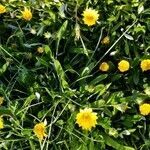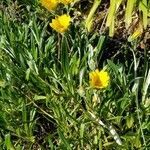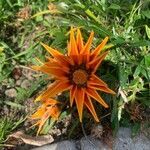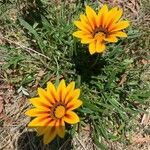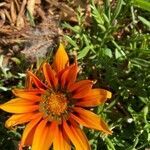Stems sometimes proximally woody. Leaves mostly basal; blades either linear to lanceolate and not lobed, 10–20(–38) cm × 6–10 mm, or oblanceolate to oblong and pinnately lobed, 10–20 cm × 25–50 mm, or both; bases usually attenuate, margins usually entire, sometimes ± prickly, revolute, midveins prominent, abaxial faces white-villous, adaxial faces glabrate to arachnose. Heads 3.5–8 cm diam. (across rays). Peduncles scapiform, (6–)10–30(–35) cm. Phyllaries: outer lanceolate, margins prickly-ciliate; the inner with margins undulate, ciliate, with ± submarginal dark stripe, cuspidate. Ray florets 13–18; corolla laminae yellow or orange, usually each with dark abaxial stripe and adaxial basal blotch or spot, (20–)35–42 × 10 mm. Cypselae 1–2 mm; pappi of 7–8 scales 3–4 mm.
Perennial. Stems rhizomatous; old lvs persisting. Lvs tufted at tips of rhizomes, usually entire, rarely pinnate, linear-oblanceolate, (10)-15-20 × 0.5-1 cm, tapered to long petiole; upper surface with sparse short bristles or glabrous, green; lower surface with dense appressed white tomentum, with glabrous or rarely bristly midrib; margins with sparse short bristles, revolute. Capitula solitary; peduncles (15)-20-30 cm long. Involucre 1.5-2.5-(3) cm diam., turbinate. Involucral bracts in 2-3 rows, usually with marginal bristles or glabrous, sometimes with cobwebby tomentum; free portion linear, equal or > fused portion. Ligules yellow to orange, with or without dark, white-centred blotch at base, 2.5-4.5 cm long. Disc florets dark. Achenes not seen.
Perennial herb, 0.1-0.3 m high. Leaves in basal rosettes, 80-300 x 1-10 mm (rarely 25 mm wide), linear/lanceolate (rarely elliptic); undivided, or some pinnatifid, or all pinnatifid, with 1-6 laciniae, upper surface smooth/rough with setulae, lower surface tomentose, except for midvein. Capitula on scapes 100-350 mm long, usually shorter than leaves, few solitary linear bracts; involucre campanulate; scales terminal, few parietal, 2-or 3-seriate; outer involucral scales linear, margins ciliate; inner involucral scales very finely acuminate, 8-18 x 2 mm, margins entire. Ligules yellow/orange, sometimes basal spots. Flowering time all year, rainfall dependent.
Tufted, acaulescent perennial with woody rootstock to 20 cm, decayed leaf bases accumulating as a fibrous sheath. Leaves mostly pinnatisect, some linear-oblanceolate, leaflets linear to elliptic, white-felted beneath, sometimes rough above, margins revolute. Flower heads radiate, yellow or orange with dark ring; inner bracts attenuate.
A herb. It forms mats or clumps. It keeps growing from year to year. It has a single taproot. The leaves are narrow and dark green. They are shiny above and white and woolly below. The flowers open in the morning and close at night. The flowers are 8 cm across.
